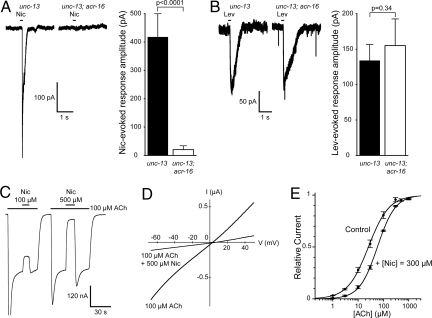Fig. 5.
Nicotine acts mainly as an allosteric inhibitor of the L-AChR. (A) Nicotine fails to activate L-AChR significantly in vivo. In whole-cell recordings from C. elegans body-wall muscles, a strain lacking both acr-16 and unc-13 shows no response to nicotine, unlike unc-13 mutants [mean amplitudes of the response to 500 μM nicotine were 21 ± 11 pA (n = 4) and 420 ± 80 pA (n = 4), respectively]. (B) In contrast, responses to levamisole are indistinguishable between these 2 strains [mean amplitudes of the response to 500 μM levamisole were 155 ± 37 pA (n = 4) and 134 ± 22 pA (n = 4), respectively]. (C) Responses elicited by ACh are inhibited by nicotine in a dose-dependent manner. Percentage inhibition of responses elicited by 100 μM ACh were 26 ± 2% (n = 6) for 100 μM nicotine and 93 ± 3% (n = 6) for 500 μM nicotine. (D) Nicotine inhibition is not voltage-dependent. Voltage ramps (−70 to +50 mV) in 100 μM ACh with or without 500 μM nicotine. Note that nicotine inhibition occurs over the whole voltage range (n = 10, BAPTA-injected oocytes). (E) Nicotine has a modest effect on ACh sensitivity. ACh dose–response curves were performed with or without 300 μM nicotine. In the absence of nicotine, EC50 and nH for ACh are 26 ± 3 μM and 1.05 ± 0.06 (n = 6–13), respectively. In the presence of nicotine, EC50 and nH for ACh are 58 ± 3 μM and 1.23 ± 0.06 (n = 5), respectively.

